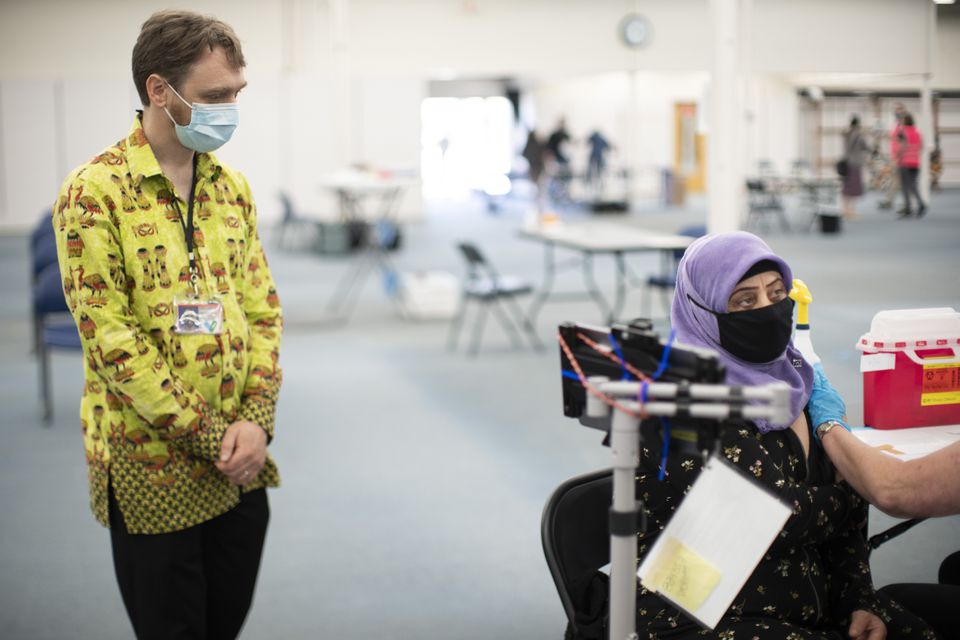PORTLAND — The old building on Southeast 122nd Avenue had once been home to a Fred Meyer serving a generation of World War II veterans and their families. Later, it was repurposed as a Fabric Depot with a cult following among crafters.
Wednesday, it was the site of COVID-19vaccinations for residents living in the least-vaccinated part of Portland.
Ulmaskhon Rustamova was among those who arrived in the morning, finally ready to get a shot.
The 56-year-old immigrant had been bombarded with misinformation on WhatsApp messages and from relatives in Russia. She’d been afraid after hearing false rumors, including that people die two years after getting vaccinated.
But she decided to do it after many of her relatives did, she said, even though she still wasn’t sure what would happen to her.
“People say all sorts of things,” she said. “What will happen, only God knows.”
Months after vaccines first became available, hundreds of thousands of eligible Oregonians remain unvaccinated, even as supplies are so abundant that thousands of doses are thrown out every week.
Now, state and local health officials are trying to target as many stragglers as they can, especially in communities like those in east Portland and Multnomah County’s eastern suburbs, where some of the most underserved and under-vaccinated populations reside.
County health officials are banking on more people agreeing to get vaccinated if the clinics they offer are near them. Since vaccine uptake has slowed down, the county has focused almost entirely on communities east of 82nd Avenue, a spokesperson for the county said.
“Pivoting to those with the highest barriers has always been our approach and will continue to be until every community in Oregon and Multnomah County is protected from COVID-19,” Julie Sullivan-Springhetti said in an email.
That’s where the former building of the Fabric Depot, at the intersection with Southeast Stark Street, comes in. The county chose the site primarily because of its location, said Tasha Wheatt-Delancy, executive director of the county’s community clinics program.
At 44.8%, the location’s 97233 ZIP code has among the lowest vaccination rates in the state among areas with at least 5,000 residents. It has the lowest rate of any urbanized part of Multnomah, Washington and Clackamas counties with that many people, ahead of only rural Molalla.
It’s also in a part of the county with low access to health care, historically high COVID-19 positivity rates and an overall high disease burden, Wheatt-Delancy said – all reasons that factored into the county’s decision to start vaccinating there.
“It’s in the right area,” said Wheatt-Delancy.
She has started calling it the “Vaccine Depot.”
Multnomah County has for more than two weeks been running vaccination clinics there, inside what now feels like a vast warehouse without the former toy aisles, grocery coolers and fabric racks.
On Wednesday, a trickle of people moved through the county’s vaccination stations, eventually landing in the 15-minute waiting zone in case they had side-effects. The vast majority of people coming through were people of color. At least half a dozen, including Rustamova, needed an interpreter.
So far, two county programs have administered 441 shots there over the seven days they’ve held clinics. Officials plan three clinics a week at the location for now, and at least one a week through August.
Ease of access was critical for some getting shots Wednesday morning.
Mitshi Lam was waiting for months for her mom to decide to get a shot, despite the Vietnamese woman’s fears about side-effects. But when Trang Lam, 51, finally relented after cooking up a plan to go to Florida, getting her vaccinated was easy.
It was on Mitshi Lam to make it happen, because her mother does not speak English or know how to navigate the English-language internet. After going online Tuesday to look for a clinic, Mitshi Lam quickly found a spot nearby with hours that were convenient for the both of them.
The Fabric Depot was only a few minutes’ drive away from their home.
“It’s easier to get the vaccine here,” Mitshi Lam said.
But it wasn’t just the location that mattered – it was the people. Speaking through an interpreter in Arabic, Sabah Samawi said he moved about a year ago to Milwaukie from Portland but has consistently driven the approximately 10 miles back to outer Southeast Portland to visit his doctor.
The 41-year-old’s doctor referred him to the clinic for a vaccine.
“I refuse to change,” Samawi, who is originally from Iraq, said. “I like it here.”
It’s unclear whether the county’s efforts will close the vaccination gap that has remained a stubborn reality. But what is certain is that the people getting shots there appreciate the help.
In the end, all Rustamova, the Russian immigrant, seemed to need was a guiding hand. And the county helped provide it.
After she arrived, workers gave Rustamova an iPad attached to the top of a wheeled metal stand that they pushed along as she moved from one stage of the vaccination process to another. On the other end of the device: a hired Russian speaker who helped the immigrant communicate with the county health workers.
As she waited 15 minutes after her shot, Rustamova told the interpreter on the screen that they had seemingly become fast friends.
“It was a little frightening,” Rustamova said to the interpreter on the iPad screen.
“But it wasn’t scary after all, right?” the woman said.
“No,” Rustamova said, still hesitating a little. “It wasn’t scary.”



